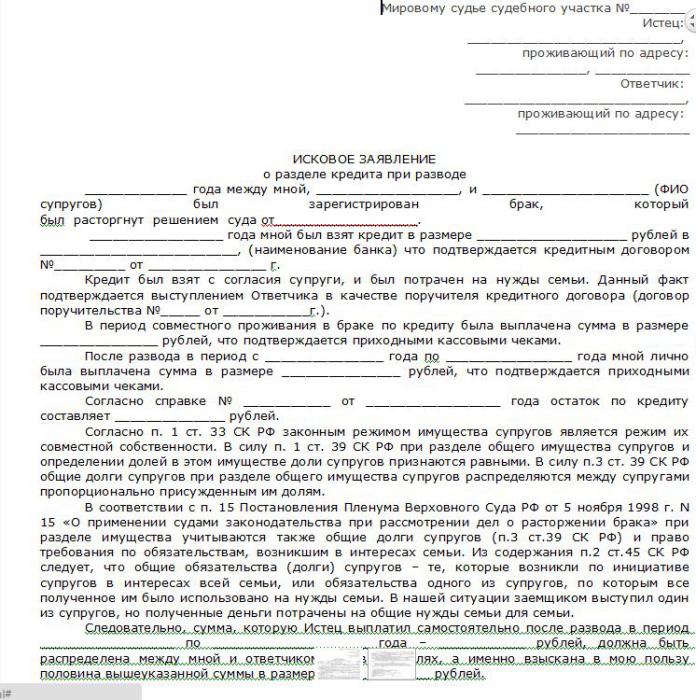Currently, the division of debts during a divorce has become a rather relevant topic, since such cases are considered in court no less often than the division of property. When entering into marriage, a person must be aware that from now on all financial issues will be resolved jointly. On the one hand, this is good, since both spouses will invest in achieving a common goal. On the other hand, all debt obligations are divided between husband and wife. This problem is quite common, and no one is safe from this.
Reasons for the situation
Why are such situations so common? In fact, the answer is simple: credit. According to statistics, every second family sooner or later takes on debt obligations. Now, as you know, loans are given not only for the purchase of real estate or a car, but also for a trip on vacation, repairs, etc. Modern life puts such a framework that it is almost impossible to save enough money. Therefore, when the time comes (depending on individual needs), you have to borrow money.

Loan amounts are different, depending on the purpose. The division of property and debts during a divorce is a rather lengthy process. The end result depends on many factors. And if the division of property is a common thing, then the division of debts has been popularized recently.
Total debts
Debt, if we consider it in the context of marriage, can be general and individual (each of the spouses separately). Under no circumstances should these concepts be confused. Jointly acquired property and debt obligations are divided between husband and wife equally or in another proportion by mutual agreement. The total debts include:
- mortgage for an apartment, a loan for the education of children, the organization of a wedding, the purchase of household appliances for the home, funds for a trip on vacation;
- those debts where both spouses act simultaneously as co-borrowers or one of them is a guarantor;
- in some cases, one of the spouses claims a thing that is burdened with debt. Then he will have to independently answer for the repayment of the loan. The second spouse can either completely abandon this thing or enter into a dispute over the right to possess it. The division of debts after a divorce in such a situation is carried out according to the desire of the spouses.
Individual debts
There are cases when a loan was issued only for a husband or wife. Moreover, the second spouse did not give written confirmation or did not know about its existence at all. In this case, the division of loan debts after a divorce is very simple: it should be paid by the one to whom it officially belongs. One of the spouses, the one who has undertaken these debt obligations, must fulfill them.

However, not everything is as obvious as it might seem at first glance. The above is relevant only if the money taken on credit was not spent on general family needs. The jurisprudence of the division of debts during divorce shows that quite often such obligations are the subject of controversy.
To prove that the debt that was formed belongs to one of the spouses, should be the second of the couple. Usually, he refers to the unnecessary things taken on credit, or using it as a gift to third parties, which does not help the family.
What debt obligations cannot be shared?
Divorce debts in most cases are shared in court. To make a final decision, you need to find out what debts you need to share and in what shares.A loan cannot be shared if it is taken before the marriage is officially registered. If a loan agreement was signed and entered into force before registration, the court most likely recognizes such a debt as an individual. To prove the opposite, we need the original checks, payment orders, testimonies of witnesses.

In addition, a loan taken to repair personal premarital property cannot be general. For example, if one of the spouses has an apartment obtained by inheritance. The debt that was taken in the event of a broken family or in a divorce proceedings is not recognized as general. Even if the marriage is not officially dissolved, however, the spouses do not live together and do not conduct a joint household. However, it is rather difficult to prove this, the help of a qualified lawyer is needed. The division of property and debts after a divorce is easier to carry out, as there are official grounds in the form of a divorced marriage.
Fictitious debts
As you know, more and more marriages are created on a contractual basis or for the benefit of one of the participants. In order to increase his share in the division of property, an unscrupulous spouse takes a fictitious loan and proves that the money was spent for the benefit of the family. If the court believes this, then the second spouse will be financially burdened. To prevent this, it is recommended to use some tips:
- A critical assessment of debt is required.
- It is necessary to draw the court's attention to the details of the transaction, the absence of requirements for repayment of debt, friendly relations between the borrower and the lender.
- If the second spouse has a small income, it is worth evaluating the creditworthiness of this person.
- It should insist on assessing the financial condition of the family. If after receiving the money taken on credit, it has not improved, then this is an occasion to doubt the fact of receiving the funds. The division of spouses' debts during a divorce is a complex process that requires the maximum amount of evidence for both parties to make an objective decision.
Debt sharing methods
In total, there are two ways of sharing debt, and there are no differences from the division of property. If normal relations are maintained between the former spouses, they themselves can agree on shares and conclude a deal. If there is a lot of controversy and claims, they go to court. When sharing the debts of spouses after a divorce, it is important to distinguish between general and individual. The easiest way is to agree. This method is also the most effective, since the spouses themselves have determined their debt obligations and, most likely, will fulfill them.

It is not necessary to certify the agreement of spouses with a notary public, in any case it will have legal force. To determine the division of debts during a divorce, you can use a marriage contract, which is currently quite often concluded. The trial begins not only with the appeal of one of the couple, but also at the request of the credit institution.
Divorce Debt Section
The institution that issued the loan is interested in having it fully repaid. If both spouses are payers, it is much easier to achieve this than by splitting the debt into two parts. When applying for a mortgage, as you know, banks require both spouses to be co-borrowers. Then, after the divorce, both the debt and the property itself are divided. The problem is that it is very difficult to sell a home until the debt is fully repaid.

When applying for a loan, the bank has the right to require that one of the couple act as the payer, the second - the guarantor. Also, a clause may be introduced into the contract, according to which the conditions are not subject to change. Even the court is not in a position to reverse such a decision. Sometimes a bank representative asks that only the payer repay the debt. The division of property and debts after a divorce by mutual agreement is not a basis for a court to share obligations between spouses.
Debt Sharing Statement
The lawsuit is filed by the couple who are interested in dividing property and debt obligations. It is a statement in court of claims that reflect the rights of the plaintiff. The statement shall indicate the total debts and the method of their distribution. Before taking this step, you need to take care of the evidence base so that the court takes the side of the plaintiff.
Such a lawsuit may be filed simultaneously with the application for divorce or separately from it. The defendant has the right to the floor and may file a counterclaim where he sets out his claims. When applying to the court, any citizen must pay the state fee. Its size depends on the sum of the division of property and debt obligations. The duty is calculated according to the law and can range from 500 to 50,000 rubles. A sample application for the division of debts after a divorce can be found at a lawyer or independently using the Internet.
How to write a statement, what documents to attach?
The lawsuit must indicate joint debts, which are subject to division. In addition, it is mandatory to mention the amount of loans and distribution methods. For example, 50/50; 1/3 of the plaintiff, 2/3 of the defendant, etc. The collection procedure must be justified and documented.

It is necessary to attach to the lawsuit official papers confirming the existence of a marital relationship between people, as well as evidence that the debts were acquired during the marriage and all the money received was directed to the needs of the family. From the documents confirming this fact, there are:
- an agreement on taking a loan and a transaction with an institution for the provision of paid educational services, the amount in them should coincide or slightly differ;
- loan agreement and a check for the purchase of household appliances, the amounts must also match;
- mortgage agreement;
- other official papers that confirm that debts are shared.
Mortgage debt
Of particular difficulty is the division of debts when divorcing is a mortgage. As already noted, banks require both spouses to be co-borrowers, this will allow to distribute the debt equally. However, in practice there are many difficulties, especially if the debt has not been paid and the property is still owned by the bank.
It is recommended to people who are going to divorce, to agree in advance with the creditor bank. It is necessary to notify the credit institution about the imminent divorce and try to resolve the issue of sharing the debt or selling the property. If the matter has reached the court, the final decision is sent to the bank in the form of a notice. In this case, the mortgage agreement must change in accordance with the circumstances.
It is worth noting that at the conclusion of the contract, some financial and credit organizations include a clause on the impossibility of changes. Then nothing can affect the further payment, including the court decision. The division of debts during a divorce, especially with regard to mortgages, has many nuances. Many banks offer early repayment of debts by opening a new loan taken by one spouse or both separately.
Arbitrage practice
Despite the prevalence of such situations, there are currently no conclusions drawn on the basis of court proceedings. In each case, a different decision is made. Often a court awards a joint payment without dividing the debts into parts.

When writing an application, it is necessary to prepare in advance all the necessary documents and evidence base, depending on the method of dividing debts. The court is also based on the presence of minor children and respect for their interests. Recently, the share of fictitious debts has increased significantly, and therefore the court carefully considers the case before recognizing debt obligations as common.
Conclusion
At the end of this article, we highlight some theses:
- shares of spouses may be joint or personal;
- total debt is formed in the process of marriage and is created to increase the well-being of the family;
- debt obligations can be divided by agreement or by court;
- mortgage debt is paid in accordance with the contract concluded when taking a loan, the bank has the right to set special conditions;
- to start the trial, you must file a lawsuit;
- the court makes a decision depending on specific circumstances, as such practice has not yet been formed.